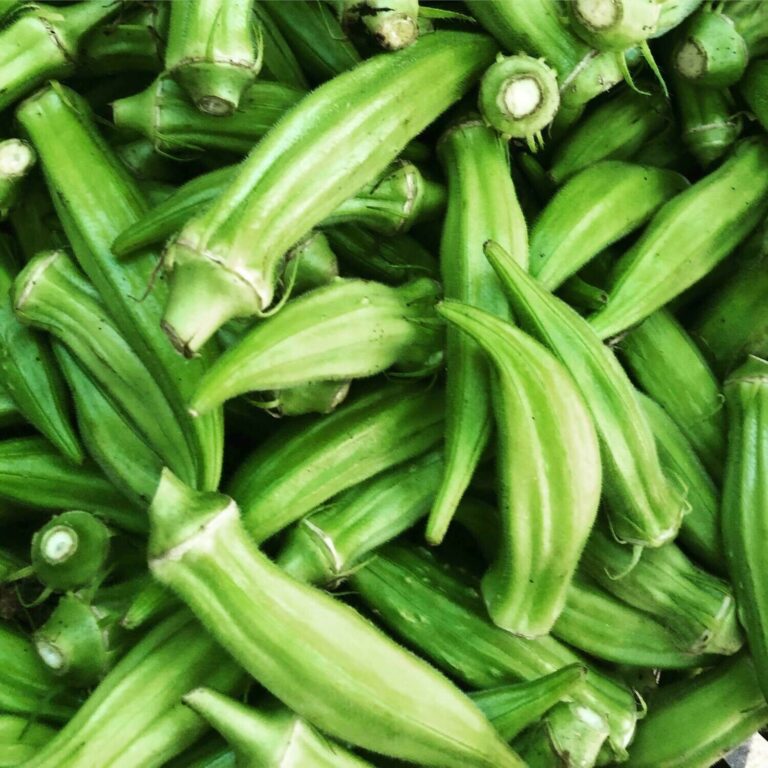Okra (Abelmoschus esculentus), also known as lady’s finger, is a popular vegetable crop widely cultivated for its edible seed pods. The plant belongs to the mallow family and has a fascinating history, with its origin traced back to Africa, where it was first domesticated.
Although okra is an annual plant in most regions, it can grow as a perennial in dry tropical regions where it is native. It is not only used for food but also grown as an ornamental plant due to its beautiful flowers.
Common Okra varieties:
- Cajun Delight
- Baby Bubba Hybrid
- Blondy
- Burgundy
- Go Big
- Clemson Spineless
Care
If you’re new to gardening, don’t worry about taking care of Okra plants. The seeds are big and easy to handle, and you just need to keep the soil moist until the seedlings pop up to get good results.
- Soil: This plant loves well-drained, sandy soil with some organic materials mixed in. When it comes to pH levels, 6.5 to 7.5 is the best.
- Water: watering your plants about once a week, or every seven to ten days, with 1 to 1.5 inches of water should be enough to keep them hydrated.
- Temperature: Although Okra likes hot and dry climates, it can still grow in cooler and more humid areas. (temperatures between 75 to 95 F)
- Light: Okra thrives in sunny areas and it requires around 6-8 hours of direct sunlight per day.
Propagation
If you’re looking to propagate some okra plants next to good old tomatoes, garlic or pumpkins, there are a few methods you can try. You can either plant the seeds directly in warm, moist soil or start them indoors.
Another option is to take cuttings from the tips of okra branches and plant them in moist soil with some rooting hormone.
You can also divide mature okra plants to create new ones. Just remember, okra loves warm soil, full sun, and regular watering to grow well.
Whichever method you choose, don’t forget to give your new plants the attention and care they need to thrive!
Give it a read

Common Pests
Frequently Asked Questions
In the vast and varied world of plants, the humble okra stands out with its impressive growth rate. Typically, it takes around 50 to 65 days from planting to harvesting. However, as with many living things, numerous factors can influence the growth of okra, such as the variety of okra, weather conditions, soil quality, and cultivation practices. The first signs of life usually appear about 5 to 14 days after planting, with the emergence of delicate green shoots. Within a couple of months, the plants will burst forth with their edible pods, and frequent harvesting will keep the cycle going, preventing the pods from becoming tough and woody.
What is the lifespan of okra plant?
The average lifespan clocks in at around 120 days. But in a study aimed at optimizing the lifespan for commercial fiber extraction, researchers took into account the one-month early harvest and one-month late harvest of okra plants. By doing so, they could determine the ideal lifespan for maximizing fiber extraction efficiency. It just goes to show that even in the plant world, every day counts towards making a meaningful impact.
What month is best to grow okra?
In order to achieve optimal yields, it is recommended to plant okra during the spring season, approximately two to three weeks after the risk of frost has subsided. This is typically around late April or May in this area. Additionally, for a successful fall crop, it is advisable to plant at least three months prior to the first fall frost, which can occur as early as October 31st. By following these guidelines, you can ensure that your okra plants have the necessary time to mature and produce a bountiful harvest.
How much water does okra need?
Watering your plants about once a week, or every seven to ten days, with 1 to 1.5 inches of water should be enough to keep them hydrated.
